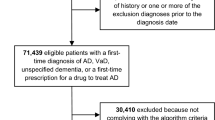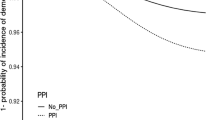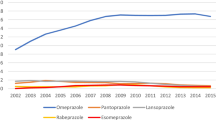Abstract
Introduction
Studies have found an association between the use of proton pump inhibitors (PPIs) and dementia, but these findings may have been confounded by selection biases.
Objective
We used prescription sequence symmetry analysis (PSSA) to estimate the sequence ratio (SR) between PPI use and dementia compared with an active comparator, the use of histamine-2 receptor antagonists (H2RAs).
Methods
We conducted a PSSA on a nationwide South Korean database between 2002 and 2013. Exposure was defined as new PPI users, and outcome was defined as a new dementia diagnosis (International Statistical Classification of Diseases and Related Health Problems, 10th revision [ICD-10] codes F00-03, F05.1, G30, G31.1, G31.9, G31.82). In this study, we applied the 3-year time window. So the patients who initiated PPIs 3 years before or after their first diagnosis of dementia were included. The pairs with the time window < 6 months were excluded to minimize the potential protopathic bias. The SR was calculated as the number of patients first diagnosed with dementia after initiating PPI (causal group) divided by the number of patients first diagnosed with dementia before the initiation of PPI (non-causal group). The SR was adjusted (aSR) to avoid the distortion of results due to underlying trends in PPI use and dementia diagnosis over time. We calculated 95% confidence intervals (CIs) for the aSR. The analysis was repeated for initiators of H2RAs. Sensitivity analyses were conducted using 1-, 2-, and 6-year time windows and using the initiation of medication for dementia treatment (Anatomical Therapeutic Chemical code: N06D).
Results
Our results showed that the aSR of dementia and PPIs (7342 pairs, aSR 1.21 [95% CI 1.16–1.27]) was not higher than that for dementia and H2RAs (6170 pairs, aSR 1.91 [95% CI 1.80–2.02]). When we used various time windows and restricted the findings to the use of medication for treating dementia, the results were consistent with the main results.
Conclusion
The risk of PPIs being associated with dementia may be overestimated. Further pharmacoepidemiological studies are needed to identify the risk of dementia with PPI use.



Similar content being viewed by others
References
Tack J, Louis E, Persy V, Urbain D. Optimal use of proton pump inhibitors for treating acid peptic diseases in primary care. Acta Gastroenterol Belg. 2013;76(4):393–402.
Badiola N, Alcalde V, Pujol A, Munter LM, Multhaup G, Lleo A, et al. The proton-pump inhibitor lansoprazole enhances amyloid beta production. PLoS One. 2013;8(3):e58837.
Hardy JA, Higgins GA. Alzheimer’s disease: the amyloid cascade hypothesis. Science. 1992;256(5054):184–5.
Kim JM, Stewart R, Kim SW, Shin IS, Yang SJ, Shin HY, et al. Changes in folate, vitamin B12 and homocysteine associated with incident dementia. J Neurol Neurosurg Psychiatry. 2008;79(8):864–8.
Lam JR, Schneider JL, Zhao W, Corley DA. Proton pump inhibitor and histamine 2 receptor antagonist use and vitamin B12 deficiency. JAMA. 2013;310(22):2435–42.
Haenisch B, von Holt K, Wiese B, Prokein J, Lange C, Ernst A, et al. Risk of dementia in elderly patients with the use of proton pump inhibitors. Eur Arch Psych Clin Neurosci. 2015;265(5):419–28.
Gomm W, von Holt K, Thome F, Broich K, Maier W, Fink A, et al. Association of proton pump inhibitors with risk of dementia: a pharmacoepidemiological claims data analysis. JAMA Neurol. 2016;73(4):410–6.
Tai SY, Chien CY, Wu DC, Lin KD, Ho BL, Chang YH, et al. Risk of dementia from proton pump inhibitor use in Asian population: a nationwide cohort study in Taiwan. PLoS One. 2017;12(2):e0171006.
Booker A, Jacob LE, Rapp M, Bohlken J, Kostev K. Risk factors for dementia diagnosis in German primary care practices. Int Psychogeriatr. 2016;28(7):1059–65.
Yoshida K, Solomon DH, Kim SC. Active-comparator design and new-user design in observational studies. Nat Rev Rheumatol. 2015;11(7):437–41.
Sperling RA, Aisen PS, Beckett LA, Bennett DA, Craft S, Fagan AM, et al. Toward defining the preclinical stages of Alzheimer’s disease: recommendations from the National Institute on Aging-Alzheimer’s Association workgroups on diagnostic guidelines for Alzheimer’s disease. Alzheimers Dement. 2011;7(3):280–92.
Hallas J. Evidence of depression provoked by cardiovascular medication: a prescription sequence symmetry analysis. Epidemiology. 1996;7(5):478–84.
Wahab IA, Pratt NL, Wiese MD, Kalisch LM, Roughead EE. The validity of sequence symmetry analysis (SSA) for adverse drug reaction signal detection. Pharmacoepidemiol Drug Saf. 2013;22(5):496–502.
Lee J, Lee JS, Park SH, Shin SA, Kim K. Cohort profile: the National Health Insurance Service-National Sample Cohort (NHIS-NSC), South Korea. Int J Epidemiol. 2017;46(2):e15.
American Geriatrics Society 2015 Updated Beers Criteria for potentially inappropriate medication use in older adults. J Am Geriatr Soc. 2015;63(11):2227–46.
Chou CY, Chou YC, Chou YJ, Yang YF, Huang N. Statin use and incident dementia: a nationwide cohort study of Taiwan. Int J Cardiol. 2014;173(2):305–10.
Côté S, Carmichael PH, Verreault R, Lindsay J, Lefebvre J, Laurin D. Nonsteroidal anti-inflammatory drug use and the risk of cognitive impairment and Alzheimer’s disease. Alzheimers Dement. 2012;8(3):219–26.
Giannopoulos S, Katsanos AH, Kosmidou M, Tsivgoulis G. Statins and vascular dementia: a review. J Alzheimers Dis. 2014;42(Suppl 3):S315–20.
Hendrie HC, Hake A, Lane K, Purnell C, Unverzagt F, Smith-Gamble V, et al. Statin use, incident dementia and Alzheimer disease in elderly African Americans. Ethn Dis. 2015;25(3):345–54.
Wang J, Tan L, Wang HF, Tan CC, Meng XF, Wang C, et al. Anti-inflammatory drugs and risk of Alzheimer’s disease: an updated systematic review and meta-analysis. J Alzheimers Dis. 2015;44(2):385–96.
Wong WB, Lin VW, Boudreau D, Devine EB. Statins in the prevention of dementia and Alzheimer’s disease: a meta-analysis of observational studies and an assessment of confounding. Pharmacoepidemiol Drug Saf. 2013;22(4):345–58.
Lochhead P, Hagan K, Joshi AD, Khalili H, Nguyen LH, Grodstein F, et al. Association between proton pump inhibitor use and cognitive function in women. Gastroenterology. 2017;153(4):971–979.e4.
Gray SL, Walker RL, Dublin S, Yu O, Aiello Bowles EJ, Anderson ML, et al. Proton pump inhibitor use and dementia risk: prospective population-based study. J Am Geriatr Soc. 2017. https://doi.org/10.1111/jgs.15073. (epub ahead of print).
Gray SL, Walker R, Dublin S, Haneuse S, Crane PK, Breitner JC, et al. Histamine-2 receptor antagonist use and incident dementia in an older cohort. J Am Geriatr Soc. 2011;59(2):251–7.
Anthony JC, Breitner JC, Zandi PP, Meyer MR, Jurasova I, Norton MC, et al. Reduced prevalence of AD in users of NSAIDs and H2 receptor antagonists: the Cache County study. Neurology. 2000;54(11):2066–71.
Hernán MA, Hernández-Díaz S, Robins JM. A structural approach to selection bias. Epidemiology. 2004;15(5):615–25.
Tamim H, Monfared AA, LeLorier J. Application of lag-time into exposure definitions to control for protopathic bias. Pharmacoepidemiol Drug Saf. 2007;16(3):250–8.
Baker-Nigh A, Vahedi S, Davis EG, Weintraub S, Bigio EH, Klein WL, et al. Neuronal amyloid-beta accumulation within cholinergic basal forebrain in ageing and Alzheimer’s disease. Brain. 2015;138(Pt 6):1722–37.
Vitamin B12 and cognitive function: an evidence-based analysis. Ontario Health Technology Assessment Series. 2013;13(23):1–45.
Zylberstein DE, Lissner L, Bjorkelund C, Mehlig K, Thelle DS, Gustafson D, et al. Midlife homocysteine and late-life dementia in women. A prospective population study. Neurobiol Aging. 2011;32(3):380–6.
Lai E, Pratt N, Hsieh CY, Lin SJ, Pottegard A, Roughead EE, et al. Sequence symmetry analysis in pharmacovigilance and pharmacoepidemiologic studies. Eur J Epidemiol. 2017;32:567–82.
Author information
Authors and Affiliations
Contributions
All authors were responsible for the study design, the collection, analysis and interpretation of data, the writing of the manuscript, and the decision to submit for publication. All authors had full access to the data.
Corresponding author
Ethics declarations
Funding
This study was funded by the National Research Foundation (NRF) of Korea (number: 2017R1A6A3A01007946).
Conflicts of interest
Sun-Kyeong Park has previously received funding from the NRF of Korea. The NRF of Korea was not involved in the current article, so the author declares no competing interests, including specific financial interests and relationships and affiliations relevant to the subject of this manuscript. Yeon-Hee Baek, Nicole Pratt, Lisa Kalisch Ellett, and Ju-Young Shin have no conflicts of interest regarding the content of this article.
Electronic supplementary material
Below is the link to the electronic supplementary material.
Rights and permissions
About this article
Cite this article
Park, SK., Baek, YH., Pratt, N. et al. The Uncertainty of the Association Between Proton Pump Inhibitor Use and the Risk of Dementia: Prescription Sequence Symmetry Analysis Using a Korean Healthcare Database Between 2002 and 2013. Drug Saf 41, 615–624 (2018). https://doi.org/10.1007/s40264-018-0638-2
Published:
Issue Date:
DOI: https://doi.org/10.1007/s40264-018-0638-2




